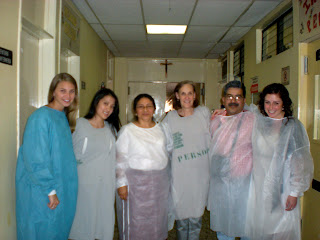I am still processing my thoughts after the incredible week I spent in Guatemala with three impressive young women, Lindsey, Gillian and Ny. Several themes have continued to resurface for me since our return.
Go with the flow—this old adage played out in many ways in Guatemala, whether it was riding in a car and spending most of the time with your eyes closed, or in running late to every meeting that was scheduled, or providing impromptu genetic counseling to a family looking for information. We really needed to be cat-like and land on our feet, ready to go in any direction. This is certainly true about life in general, and will no doubt be true as we investigate other countries looking to provide genetic services to their citizens.
When in doubt, simplify—this too cropped up in Guatemala, and was a great lesson for the GenetAssist team. We all become so comfortable talking in our scientific language, and we often had people we met look at us quizzically, not understanding our jargon. It is important to be reminded that most people have little idea of what we are talking about.
Teamwork pays off—We made a very good team. We understood the goals relatively well, though they changed a bit with each meeting. We were quite respectful of one another, and yet our ability to laugh and enjoy the time there was not compromised by the seriousness of the tasks in front of us. Everyone worked hard, and put in effort beyond anyone’s expectations, and we did so because we all wanted to do so. This experience exemplifies the best kind of teamwork. Successories, a company that provides inspirational and motivational products, has a poster on teamwork. The caption is: Never doubt that a small group of thoughtful, committed citizens can change the world. Indeed, it is the only thing that ever has.
Lastly, the macadamia nut man, Lorenzo, had quite an impact on me. Part of it is his wizened, “old person” perspective on the world, basically a tough guy with a big heart. He is a contradiction of emotions. He longs for a simple life and reluctantly utilizes modern technology to make his farm work. He eats broccoli for breakfast even though he would rather have pancakes because he wants to stay healthily alive. He is disdainful of politicians (“the only thing on their minds is getting reelected”) and university academicians (“ they may be smart, but they have no common sense”). He is sad at the state the world is in, and it seems part of him wants to just run away but he doesn’t; instead, his response has been to build something that will make a difference in the world.
His passion is anything macadamia. Oils for making women beautiful, the best pancakes I have ever had (not much of a pancake person, but these were so good…), decreasing the amount of carbon in the air.
His most poignant pearl for me related to his world view, that we are just small pieces of a much bigger picture, that we have to work at not getting caught up in the trivial, unimportant things that can sidetrack us, that it is foolish not to appreciate the beauty of what we have around us in this short life here on this planet.


















































